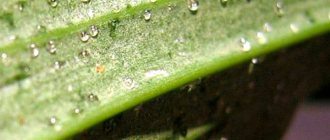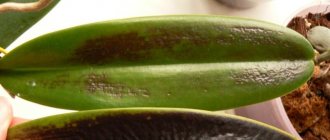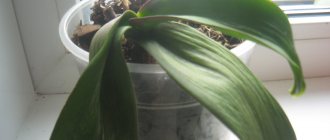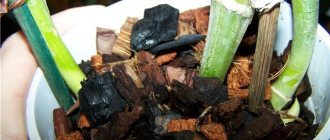If the orchid leaves have lost their turgor and are wrinkled, first of all you need to look for the cause in improper care. When considering the options for why an orchid's leaves wither, you need to check the conditions of its maintenance, the regime of watering and fertilization. Before saving an orchid, inspect its root system, since the flower may not feel well due to root disease.
To determine what to do with phalaenopsis, you need to study the conditions in which it is kept: room temperature, soil quality. The method of resuscitation will depend on the cause of the disease.
Causes of soft orchid leaves
Most often, the reason why an orchid withers is a lack of nutrition in the ground part. The lower leaves wither first. If the roots do not have time to replenish the supply of liquid and nutrients, then the lower part of the orchid gives up its reserves to the upper part.
Many problems are solved after transplanting a flower. Attention is paid to the roots of the phalaenopsis, the damaged ones are cut off. They are able to recover even if up to 95% of the roots have died.
Wilting in orchids begins with the lower leaves.
Orchid turgor can be restored by changing the regime of watering and spraying the plant. If the situation has not changed, then the reason must be sought in the temperature regime: move the pot to a warmer or, conversely, cooler place. If a plant dries out in a pot, you need to think about the quality of the soil and its density. The substrate must be loose and porous.
During the period of active growth and after flowering, the orchid needs fertilizer, but there should not be a lot of it - this will immediately affect the condition of the roots and shoots.
Quick Help Techniques
The owner of such an exotic plant as an orchid needs to remember that in its essence it is very life-loving and is able to recover even in the complete absence of a root system . The rapid drying of the leaf apparatus is no exception. The main thing is to quickly establish the cause and urgently take recovery measures.
Even with a complete absence of roots, an orchid can be revived.
Advice! A more attentive attitude to the plant and preventive measures will help avoid many problems.
Reactive drying of foliage in most cases is associated with complete damage to the root system or root collar. Quick measures involve removing all damaged areas (completely dried leaves, roots and damaged areas on the root collar), processing the cut sites and replanting the plant in a new, high-quality substrate.
Other reasons that cause rapid drying of leaves come down to proper care of the plant.
Insufficient watering
Insufficient watering is the most common reason why an orchid has limp leaves. If the substrate in the pot is dry, then the roots have nowhere to get moisture and they cannot nourish the shoot.
If the leaves have become soft and wrinkled, you can quickly return them to shape by normalizing watering. To do this, special attention is paid to the root system. Pots for orchids are specially made transparent so that you can see whether the root system has dried out. There should always be condensation on the inner walls of the pot. The watering interval depends on several factors: lighting, room temperature, and looseness of the substrate.
After a few days of proper watering, the leaves regain their elasticity. If the process is slow, a solution of succinic acid is used. The leaves and trunk are washed with it, and the root system is immersed in the solution for several hours. For active growth and flowering, you can spray the entire plant with succinic acid 2 times a month. The optimal temperature of the succinic acid solution is 30-40°C.
A glucose solution will help revive the flower. To prepare syrup 4 tsp. sugar is dissolved in a glass of water. Every evening the solution is applied to the outside of the leaf and washed off the next morning. This prevents excessive moisture loss. The course lasts 4 days, then take a break and, if necessary, repeat the course again.
Watering with sugar water restores the orchid.
Since sugar is a breeding ground for sooty fungus, it is important to rinse off the solution well.
Viruses
The greatest danger to orchids is from viruses. There is no treatment, so viral diseases of orchids are the certain death of the flower. When pruning plants with pruning shears, scissors, or when handling other sharp objects, it is necessary to disinfect all tools, otherwise the orchid may become infected with a virus.
Infection occurs during general watering if there is a sick flower nearby. If poorly cared for, the plant becomes very vulnerable to viruses. The disease appears as large ring-shaped or round spots on the leaves.
The infected orchid is isolated from others. All plants are treated with a broad-spectrum antibiotic and fungicide. This will not protect against the virus, but will strengthen the flowers’ immunity.
Edema
Excessive watering
If your orchid's leaves are wilting, it may be overwatering. In this case, the phalaenopsis withers completely: the roots rot, and healthy ones become insufficient to provide nutrition to the entire plant.
The plant can be cured; this will require a number of measures:
- Remove the plant from the substrate.
- Inspect each root and remove rotten tissue to healthy tissue.
- Treat the sections with charcoal, cinnamon or fungicide powder.
- Leave the roots to dry for 10 hours.
- Prepare a new dry, loose substrate.
- Replant the plant.
The plant needs to be watered when the roots have acquired a bluish-gray tint. If they are bright green, then they have enough moisture to nourish the flower. If the leaves wrinkle, the orchid is left without watering for several days.
Edema
Orchid bark - selection and preparation
Swelling, bumps, or depressed spots may appear on orchid leaves. This occurs due to the plant being in contact with water for too long, as well as due to the air temperature being too cold (below 14 °C).
With excessive watering, especially in the cold season, swelling often occurs on the leaves. The danger of this phenomenon is that the swollen parts of the leaves quickly rot, and pathogens of fungal and bacterial infections easily enter them. Leaves covered with swelling or tubercles must be removed.
Hypothermia
The orchid is a tropical plant, it is sensitive to the temperature in the room. Keeping a plant in a draft or at sub-zero temperatures causes the leaves to wrinkle, their elasticity to decrease, and they gradually lose all moisture and droop.
In winter, do not place a pot with a plant on the windowsill if the temperature outside reaches -15°C. Completely frostbitten leaves are not treated; they are cut off to avoid the formation of rot and its spread to healthy tissue.
There is no need to replant a supercooled flower. If the orchid has soft, limp leaves, you can save them as follows:
- Inspect the root system, dead roots are removed, and the cuts are processed.
- If all the roots are frozen, you can grow them. To do this, the flower is lowered into the solution. The following are diluted in 1 liter of warm water: 1 ampoule of “Etamon”, 1 drop of “Radipharma”, 4 drops of “Cycron” or 2 drops of “Ribav-Extra”. The roots will grow in 1-2 months if you place the plant in clean water, a mixture of bark and moss, clean moss, or create a mini-greenhouse, for example, from a plastic bottle.
- Return the flower to the dry substrate.
- Provide moderate watering and fertilization.
Basic care mistakes
Experienced flower growers advise not to make common mistakes when purchasing and caring for them. This floral look is often purchased for its spectacular appearance, but after being placed on the windowsill, people often don’t know what to do with the plant. The orchid loves attention and careful, non-aggressive care.
Purchase
The first difficulty a gardener may encounter is purchasing a damaged flower. The blooming appearance can be deceiving. Temperature fluctuations lead to the spread of fungus on the roots, so when purchasing, you should pay attention not to the above-ground part, but to inspecting the root system.
The roots should be smooth, the same color, without plaque or dry spots. They should fit snugly into the pot. The formed buds should not fall off when slightly shaken due to their tight attachment to the stem.
Watering
Orchids are often watered from watering cans or through wide trays. This leads to waterlogging of the roots. Irrigation trays should not be too deep and wide, then there will be no excess moisture. There is another method - immersing the pot in a bucket of water.
Experienced flower growers and collectors of exotic flowers water plants using the wick method. When transplanting, a wick is placed at the bottom of the pot, which is constantly moistened. In this way, the stem is constantly fed with a small amount of moisture, which does not lead to an excess.
Accumulation of substrate at the root collar
This is a common problem that causes flower loss. When purchasing, the owner does not have the opportunity to examine the substrate on every part of the container. Moisture-intensive soil accumulates near the root collar and leaves it wet for a long time. Such a moisture-intensive substrate can be a lump from previous transplants, which consists of several layers.
Increasing humidity by spraying
This mistake is associated with the idea of the orchid as a moisture-loving crop. The owners begin to actively spray the plant along its entire length. Sometimes the buds are sprayed. There is no need to do this. An error can lead to rotting and loss of the phalaenopsis. Humidity is important for epiphytes, but this is achieved by installing humidifiers near the pot or spraying the air near it.
errors in care led to wilting of orchid leaves
The appearance of pests
The danger comes from pests that appear as a result of imperfect temperature conditions. Humidity or dry air leads to active reproduction of parasites. Orchids are susceptible to attacks from various insects:
- mealybug;
- aphid;
- whitefly;
- spider mite;
- thrips.
The fight against any species involves carrying out step-by-step treatment measures. First, the culture is rid of adult individuals, then the remains of deposited larvae are eliminated, and treatment begins.
Dense substrate
Air should always circulate between the roots of the orchid. This is a prerequisite for the flower, in addition to the moist environment in the pot. If your phalaenopsis leaves are wrinkled, the cause may be a dense substrate.
The substrate for the orchid should be loose.
The loose substrate provides ventilation for the roots, they remain healthy and do not rot, and excess moisture is easily removed. If the orchid withers, it means that these conditions are not met.
The cause of leaf wilting is eliminated by completely replacing the substrate. Properly processed, high-quality bark easily absorbs water, filtering it through its pores.
Why did the rhizomes change color?
It happens that orchid rhizomes change color and turn yellow . A similar phenomenon occurs because the roots do not have enough light, they are dark. Perhaps, when transplanting, they deepened it quite deeply into the soil, or placed the pot in a dark place. But for exotic handsome men this is unacceptable.
The root system should have enough light and air space. Otherwise, the process of photosynthesis, which produces the pigments responsible for green color, stops. Therefore, it is extremely important to plant orchids in a transparent container with loose, breathable soil.
A serious problem is when yellow roots are the initial stage of rotting . In this case, it will be more difficult to cope with the infectious disease. But, as already noted, the main thing is to recognize the cause in time.
Overheat
The orchid does not like direct sunlight and hot radiators. If the leaves of a phalaenopsis wither, you need to check the air temperature in the room; the plant may have overheated.
In addition to the sun, heating comes from heated glass if the pot is on the windowsill. The leaves begin to actively evaporate moisture, the substrate heats up, and evaporation occurs in the pot. The roots experience a lack of moisture and cool down as the heat of the substrate is spent on evaporation.
In summer, the maximum air temperature for an orchid is 25°C. If limp leaves are found on the orchid, the pot should be moved to partial shade or another less hot place.
It is necessary to take measures to save the orchid immediately, otherwise the plant will quickly die; in a matter of days it can dry out completely; both the roots and the ground part will dry out to the same extent.
If the plant has been overheated for a short time, a period of several hours to several days will be enough for it to recover on its own. It is forbidden to spray the plant when it is under the sun's rays - this will cause the leaves to get burned. Spraying in summer is effective only in the evening.
When the plant is in the shade and the temperature of the roots and ground parts is equalized, the orchid can be wiped with a damp sponge and watered. To speed up recovery, add succinic acid or a drop of Epin to the water.
Why do leaves wither and turn yellow after transplanting?
Epiphytes and lithophytes are transplanted to a new location after the first flowering or as the pot becomes too small for the overgrown roots. The transplant is carried out according to the established scheme. Orchids are quite capricious, so in order to avoid mistakes, it is recommended to watch special videos and study the information.
For transplantation, select a suitable container and prepare the substrate. The roots are inspected and, if necessary, dry or damaged parts are removed with sharp garden shears. The sections are treated with crushed activated carbon to avoid fungal infection.
The leaves of the transplanted orchid began to wither
The transplant is secured with tray watering, a root biostimulator is added to the water, this will help the plant quickly adapt to new growth conditions. If, after transplantation, the leaf begins to dry out, turn yellow, and take on an unusually limp appearance, then this indicates a problem, a possible violation of the planting rules:
- Aging. This natural cause may become relevant after transplantation. Changing the pot becomes a new stage in the development of the culture, so the reset process is activated. Wilting and yellowing of the lower plates is a sign that the flower is renewing itself. In this case, each fallen leaf is removed, no other actions are taken.
- Overflow. After transplantation, a flower reacts to waterlogging by rapid yellowing of the lower part along with the stem. If this reason is discovered, it is advised to normalize the irrigation system and wait until the substrate dries completely.
- Water quality. Plants are sensitive to hard water. Rust and chlorine that get to the root system after replanting can harm the plant. To avoid damage to the roots, hard water is softened by adding citric acid.
- Incorrectly selected container and substrate. Repotting may fail if you choose a pot that is too small or too large. Lack of space compresses the roots and leads to yellowing; too much space provokes the accumulation of moisture, which is also harmful to the plant.
- Moving, incorrect placement. The reason for yellowing and wilting after transplantation may be the wrong choice of location. Exotic flowers do not feel comfortable in the kitchen, where they are often adjacent to fruits and vegetables. Some fruits actively emit ethylene, which leads to the activation of processes inside the flower, which negatively affects its natural development.
Advice! After transplanting, during flowering, it is recommended to water the soil with warm, settled rain or melt water.
Large amount of fertilizers
Feeding an orchid should be done with caution: both a lack and an excess of feeding can lead to sagging leaves. Before using any fertilizer, you must read the instructions. It is not recommended to mix several types of fertilizers in hopes of getting the best results.
If the orchid's leaves have wrinkled, it may have been watered with a highly concentrated solution. The orchid will die if measures are not taken. If the leaves begin to fall, the substrate is watered with water without fertilizing. In a situation where nothing has changed in several days, it is necessary to change the soil or look for another reason.
Orchids are especially sensitive to phosphorus, potassium and other salts. If there is an excess of them, the leaves may turn yellow and fall off.
Preventive measures
In order to minimize the risk of yellowing on the leaves of your phalaenopsis (as well as other diseases), you must follow some preventive measures:
- Water the plant properly . For a healthy flower, the immersion method is most suitable. For hydration, use the “right” water. Try not to over-water the flower, because the plant tolerates a lack of moisture more easily than its excess.
- Do not water the leaves of the flower, do not use cold water . When moistening, do not immerse different plants in one container, this can lead to widespread diseases.
- Try to maintain the required air humidity , use any available means to moisturize. If the air is very dry, sometimes you can spray the plant with a spray bottle using the finest spray.
- Only fertilize the plant if it is completely healthy . It is not recommended to fertilize during flowering. When applying fertilizers, follow the dosage. Fertilize according to the schedule. Orchids need timely application of fertilizers not only for beautiful flowering, but also to create conditions close to the natural environment.
- You cannot replant during flowering, and after flowering you need to trim the peduncle . This is done with a clean, disinfected instrument, and then the pruning area is treated. After transplanting, do not forget to immediately water the phalaenopsis generously.
- Keep young plants separate from those that have been with you for a long time.
Root diseases
The turgor of orchid leaves decreases due to various diseases of the root system. The most common are drying out and rot. To cure a plant, you need to cut off the affected roots, treat them, change the soil, water and fertilize the orchid.
You can tell that the problem is in the root system by its color: healthy roots should be green or have a silvery tint, they feel dense and hard to the touch. Young roots are light, gray, and turn green when wet. If they become soft and weak, hollow, slimy, brown spots, rotten or dry areas appear on them, and water flows out of them when pressed, then urgent treatment is needed. If you do not change the substrate for a long time, algae and bacteria appear on the bark, it wears off and the pores become smaller. Such roots are not able to absorb moisture and nourish the plant.
Until the root system is restored and the cuts are healed, the plant is not fertilized to avoid burns.
Step-by-step guide to restoring an orchid:
- Make sure that the flower has been provided with proper care, that it is not overdried and has not been subjected to overheating or frostbite.
- You can determine the strength of the root system by shaking the plant trunk. If the leaves of a phalaenopsis orchid wither and it wobbles in the ground, the trunk does not hold tightly, which means the roots are damaged.
- If the plant wobbles, then the problem lies in the roots. If it stands firmly, inspection of the roots is carried out in order to prevent and stop the disease at an early stage.
- Rotten, mucus-covered and dried roots are removed.
- Root sections are treated with alcohol-free antiseptics or crushed charcoal.
- Rooting is carried out with the addition of the preparations “Alirin” and “Maxim” to the water.
- If there is at least one healthy root, it is planted in a pot and provided with daily care.
- In the absence of healthy roots, they are built up.
Root rot in an orchid.
Method for growing phalaenopsis roots:
- The flower is placed above a vessel with water, the neck of the flower should be above the water at a distance of 2 cm, that is, none of the parts of the orchid should come into contact with the liquid.
- The container is transferred to a well-lit place, but not under direct sunlight.
- The leaves are wiped on both sides with a special fertilizer for orchids or sprayed with succinic acid. To activate root growth, 4 tablets of acid are diluted in 1 liter of water.
- After an air bath, the leaves are moistened with a mixture of vitamins B1, B6 and B12. 1 ampoule of each vitamin is diluted in 1 liter of water.
You can replant the orchid in the ground when the roots reach 5 cm in length, this will happen in 2-3 months.
If the root has not completely rotted, but only at the edge, and it still has a healthy beginning, then only the damaged part is cut off. The remainder of the root is still able to nourish the orchid, and healthy tissue forms over time at the cut site.
Pests
The leaves become wilted and dry out due to pests. For orchids, parasites such as spider mites, mealybugs, and thrips are dangerous.
Mite
If the leaves become sticky and sticky, it means they have been infected by spider mites. It is necessary to water and spray the flower, and then cover it with polyethylene. Moist air will help get rid of the pest.
Thrips
Thrips appear on orchids quite often. They can move to other plants, so the diseased flower must be isolated. Grooves and black dots remain on the leaves. These are the most important signs indicating that thrips have appeared on orchids.
Thrips
Experienced flower growers know how to deal with these pests. It's not easy to get rid of them. Systemic insecticides will be needed. They need to be taken 2 times more than recommended in the instructions. The product is dissolved in water and any foaming detergent (for example, shampoo) is added. The flower is washed with this product. This procedure must be repeated three times with an interval of 10 days.
Mealybug
A white coating on orchids indicates that a mealybug has infested the flower. This pest can destroy it in a short time. Beginners often encounter cases when a white sticky coating appears on the orchid. It is important for all gardeners to know how to treat a plant.
It is necessary to place the diseased orchid separately from other plants and check the conditions of its maintenance: the bug often affects flowers weakened by improper watering or poor lighting. Then manually wipe all parts of the orchid with a wet cotton pad. After this, wipe them again with a cloth soaked in a soap or alcohol solution. At the end, the flower along with the soil is treated with an insecticide: “Fitoverm”, “Mospilan”, “Aktellik” or “Aktara”. The procedure is repeated 3-4 times with an interval of 10 days.
The plant may also become covered with a white coating due to a fungal infection. Pest control will help keep indoor flora alive.
Orchids need good, proper care at home. If the grower did something wrong, then there are ways to keep it alive and restore flowering. It is necessary to select suitable lighting, adjust the frequency of watering, replant in new soil, and treat with special preparations.
Prevention
Avoiding such unpleasant situations is possible only with proper care of the orchid.
- Maintaining a comfortable temperature in summer: +22-25ºС, in winter +16-18ºС. The difference in temperature differences should not exceed 5ºС.
- Lighting is required diffused, with a daylight duration of 14 hours.
- Choose a pot that suits the size of the flower.
- Humidity within 50-60%. Be sure to regularly ventilate the room.
- Renew the substrate every 2-3 years.
- Water once a week; in between, the soil should dry out completely.
- The water temperature should be 35-40ºС.
- Spray 5 times a day. Avoid the procedure during the flowering period.
Whatever one may say, without basic rules of care, it will not be possible to grow a beautiful and healthy plant. Therefore, before purchasing, read the requirements for growing orchids . In this way, you will protect not only the flower from various health problems, but also your nervous system.











